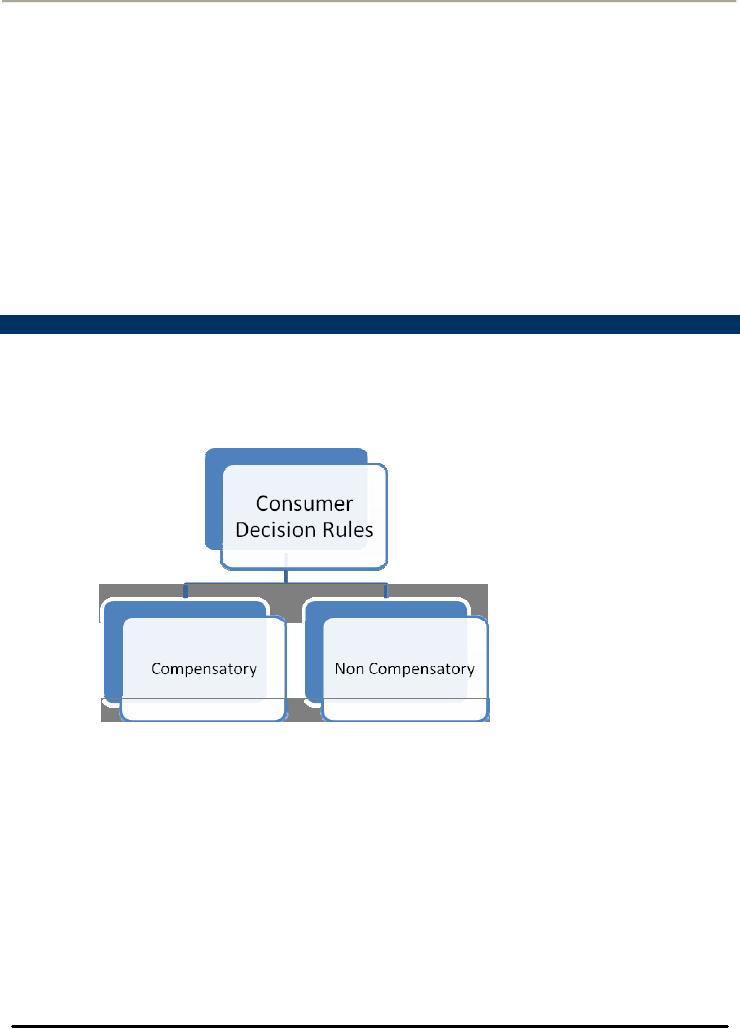 |

Consumer
Psychology (PSY -
514)
VU
Lecture
38
Decision
and Purchase
Understanding:
�
Consumer
Decision Rules
o
Compensatory
Decision Rules
o
Non-Compensatory
Decision Rules
Conjunctive
Decision Rules
Disjunctive
Decision Rules
Lexicographic
Decision Rules
�
Output
o
Purchase
Behavior
o
Post
Purchase Evaluation
Beyond
the Decision Consuming and
Possession
Relationship
Marketing
1.
Consumer Decision Rules
Consumer
decision rules are the
procedures used by consumers to
facilitate brand (or other consumption
related)
choices.
These rules reduce the burden of making
complex decisions by providing guidelines
or routines that make
the
process less taxing.
Two
Categories of Consumer Decision Rules
are:
1.
Compensatory Rules
A
consumer determines a brand or model
options in terms of each relevant
attribute and computes a weighted
or
summated
score for each brand. The
assumption is that consumer
will select the brand that
scores the highest
among
the alternatives evaluated. Compensatory
decision allows a positive evaluation of
a brand on one attribute
to
balance out a negative evaluation on
some other attribute.
2.
Non-Compensatory Rules
Non
Compensatory Decision Rule does
not allow consumers to
balance positive evaluation of brand on
one
alternative
with a negative evaluation of brand on another
alternative.
Types
of Non-Compensatory Rules
There
are three types of
Compensatory Rules
a.
Conjunctive
Decision Making Rules
122

Consumer
Psychology (PSY -
514)
VU
b.
Disjunctive Decision Making
Rules
c.
Lexicographic
Decision Making Rules
a.
Conjunctive
Decision Making Rule
The
consumer establishes a separate
minimally acceptable level as cut off
point for each attribute. If
any particular
brand
or model falls below that
cut off point on any
one of the attributes the option is eliminated
from further
consideration.
Conjunctive Decision rule can result in
several acceptable alternatives. It
becomes necessary for
consumers
in such cases to apply some
additional decision rule to arrive at a
final conclusion. To select the
first
satisfactory
brand conjunctive rule is particularly useful in
reducing the choices, after that
consumers may apply
another
refined decision rule.
b.
Disjunctive
Decision Rule
Disjunctive
Rule is the mirror image of the
conjunctive rule. In applying the disjunctive rule the
consumer
establishes
a separate minimally acceptable
cut off level for each
attribute. This will further
minimize the choices
though
still the choices will be
more than one. Here the
consumer may accept the
first satisfactory alternative as
the
final choice or may apply another rule
that may be more
suitable.
c.
Lexicographic
Decision Rule
The
consumer first ranks the attributes in
terms of perceived relevance or
importance. The consumer
then
compares
the various alternatives in terms of
single attributes in terms of a single
attribute that is the
most
important.
If one option scores
sufficiently higher on this top-ranked
attribute it is selected and the
process ends.
When
two or more options ranks
sufficiently higher then the process is
repeated on the second highest
ranking
attribute
until the process
ends.
Implications
for Marketers
With
the lexicographic rule, the highest ranked
attribute (the one applied first)
may reveal something about
the
individual's
basic consumer orientation.
Buy
the best rule
might indicate that consumer is
quality
oriented, status
oriented,
or
economy minded.
Consumers'
Shopping Strategy
According
to shopping strategies consumers can be
divided into following
categories:
�
Practical
Loyalists
those who look for
ways to save on the brands
and products they would buy
anyway.
�
Bottom-line
Price Shoppers-
those who buy the lowest
priced item with little or no regard
for the brand
�
Opportunistic
switchers-
those who would use
coupons or sales to decide
among the brands that fall
within
their
evoked set
�
Deal
Hunters-
those who look for the
best bargain and are
not brand loyal
2.
Output
Output
portion of consumer decision making model
concerns two kinds of closely
associated post
decision
activities:
1.
Purchase Behavior
2.
Post Purchase
Evaluation
1.
Purchase Behavior
In
studying the consumers' purchase
behavior, it is important to understand
what types of purchases
consumers
make.
Types
of Purchases
Consumers
make three types of
purchases:
a)
Trial Purchase
b)
Repeat Purchase
c)
Long Term Commitment
Purchase
123

Consumer
Psychology (PSY -
514)
VU
a)
Trial Purchase
When
a consumer purchases a product
(or brand) for the first time
and buys a smaller quantity
than usual this
purchase
would be considered a trial.
Trial is the exploratory phase of
purchase behavior in which
consumers
attempt
to evaluate the product through direct
use. For example when
consumers purchase a new brand
of
laundry
detergent about which they
may be uncertain they are likely to
purchase smaller trial quantities
than if it
were
a familiar brand. Consumers may
also be encouraged to try
new product through such
tactics as free
coupons,
samples and or sale
price
b)
Repeat Purchase
When
a new brand in an established product
category (toothpaste, detergent powder,
cola drinks) is found by
trial
and
found to be better than other
brands, consumers are likely
to repeat the purchase. Repeat
Purchase is closely
associated
with the concept of Brand
Loyalty
Most
firms try to encourage brand loyalty
because it contributes to greater
stability in the market. Unlike
trial in
which
consumer uses the product on a
small scale and without
any commitment, repeat purchase
usually signifies
that
the product meets with the
consumer's approval and that
s/he is willing to use the
product again and in
larger
quantities
Trial
of course is not always
feasible especially in case of durable
goods. If consumers are
purchasing refrigerators,
electrical
ranges, washing machines.
Along with the selling of durable
goods comes the concept of
Display
Centers.
Consumers
can go to the cars display
centers where they may sit
in the car see every thing
and may have a
test
drive
also. This is to furnish
their trial of the product.
With the advent of the internet display
centers are now
also
virtual
(homes).
c)
Long-Term
Commitment Purchase
2.
Post Purchase
Evaluation
As
consumers use a product
during the trial purchase, they
evaluate its performance in the
light of their own
expectations.
There
may be three possible
outcomes of the trial
purchase:
Actual
performance matches the expectations,
leading to a neutral
feeling
Performance
exceeds expectation, causing what is
known as positive
disconfirmation of expectations (which
leads
to satisfaction)
Performance
is below expectations causing what is
negative
disconfirmation of expectations (which
leads to
dissatisfaction)
Important
component of post purchase evaluation is the
reduction of uncertainty; consumers might
have had
about
the selection. As part of their
post purchase analysis
consumers try to re-assure
themselves that their
choice
was
a wise one.
In
order to rationalize their decision they
may:
Seek
advertisements that support
their choice and avoid the
ads of competitive
brands
They
may attempt to persuade friends,
relatives to buy the same
brand
They
may turn to other satisfied
owners
The
degree of post purchase
analysis depends
upon:
The
importance of product decision
Experience
acquired in using the
product
It
would be logical to assume that
customer satisfaction is related to
customer retention. The
findings however,
show
that retention may be more a
matter of the brand's reputation
especially for products
consumers find
difficult
to evaluate.
124

Consumer
Psychology (PSY -
514)
VU
Beyond
the Decision Consuming and
Possessing
Historically
the emphasis of Consumer Behavior has
been on product, service and
brand choice decisions.
Possessing,
collecting and consuming things is another
facet of Consumer Behavior.
Consumer choices are
the
beginning
of Consumption process not merely the
end of consumer decision making
process. Some
possessions
serve
to assist consumer in their
effort to create "personal meaning" and
to maintain a sense of past.
Relationship
Marketing
Relationship
Marketing (Loyalty Programs)
are used to foster usage
loyalty and commitment to loyalty
to
company's
products and services. A
real relationship marketing program is more
than the use of
database
marketing
tactics to better target the customers.
The consumer must feel that
he or she has received
something for
being
a participant in the relationship.
Relationship
Marketing programs have been
used in a wide variety of products and
service categories (retail credit
facility).
Many companies call their
programs a club, and some
even charge a program fee. Membership in
a club
may
serve as means to convey to
customers the notion of permanence
and exclusivity inherent in
committed
relationship.
125
Table of Contents:
- INTRODUCTION TO CONSUMER PSYCHOLOGY:Consumer Behavior
- INTRODUCTION TO CONSUMER PSYCHOLOGY:Consumer research
- INTRODUCTION TO CONSUMER PSYCHOLOGY:Marketing Mix, Product, Price
- INTRODUCTION TO CONSUMER PSYCHOLOGY:Customer Value, Perceived Value
- VALUE AND RETENTION FOCUSED MARKETING AND CONSUMER DECISION MAKING PROCESS
- CONSUMER RESEARCH:Quantitative Research, Qualitative Research
- MAJOR STEPS IN CONSUMER RESEARCH PROCESS:Design of Primary research
- QUANTITATIVE RESEARCH DESIGNS & DATA COLLECTION METHODS
- QUANTITATIVE RESEARCH DATA COLLECTION TECHNIQUES:ATTITUDE SCALES
- QUALITATIVE RESEARCH DESIGNS & DATA COLLECTION METHODS
- CUSTOMER SATISFACTION MEASUREMENT, SAMPLING, AND DATA ANALYSIS AND REPORTING
- MARKET SEGMENTATION AND ITS BASES:Geographical Segmentation
- BASES FOR SEGMENTATION: DEMOGRAPHIC SEGMENTATION PSYCHOGRAPHIC SEGMENTATION
- BASES FOR SEGMENTATION: SOCIOCULTURAL SEGMENTATION USE RELATED SEGMENTATION USAGE SITUATION SEGMENTATION
- BASES FOR SEGMENTATION: BENEFIT SEGMENTATION:Intrinsic Cues
- BASES FOR SEGMENTATION: HYBRID SEGMENTATION STRATEGIES
- MARKET SEGMENTATION IMPLEMENTING SEGMENTATION STRATEGIES ENVIRONMENTAL INFLUENCES CULTURE
- HOW CULTURE IS LEARNT ENVIRONMENTAL INFLUENCES:Formal Learning
- CULTURE AND ITS MEASUREMENT ENVIRONMENTAL INFLUENCES
- MEASUREMENT OF CULTURE ENVIRONMENTAL INFLUENCES:Consumer Fieldwork
- SUBCULTURE CHAPTER 4: ENVIRONMENTAL INFLUENCES
- AGE AND GENDER SUBCULTURE CHAPTER 4: ENVIRONMENTAL INFLUENCES
- BASES FOR SEGMENTATION: BENEFIT SEGMENTATION:Market Segmentation
- SOCIAL CLASS CHAPTER 4: ENVIRONMENTAL INFLUENCES:Occupation
- CONSUMER SOCIAL CLASSES CHAPTER 4: ENVIRONMENTAL INFLUENCES:Affluent Consumer
- CONSUMER SOCIAL CLASSES CHAPTER 4: ENVIRONMENTAL INFLUENCES:Membership Group
- CONSUMER SOCIAL CLASSES CHAPTER 4: ENVIRONMENTAL INFLUENCES:Shopping Groups
- UNDERSTANDING PERSONALITY CHAPTER 5: INDIVIDUAL DETERMINANTS OF CONSUMER BEHAVIOR
- CONSUMER PERSONALITY, TRAIT THEORY AND SELF IMAGES
- CONSUMER MOTIVATION:Needs, Goals, Generic Goals
- UNDERSTANDING LEARNING:Intentional and Incidental Learning, Implications for Marketers
- INSTRUMENTAL CONDITIONING, INFORMATION PROCESSING AND MEMORY
- ATTITUDES:Characteristics of Attitudes, Attitudes have consistency
- ATTITUDE FORMATION AND CHANGE:How attitudes are learned?
- ATTITUDE CHANGE STRATEGIES:Resolving two conflicting attitudes
- INTRODUCTION TO CONSUMER DECISION MAKING:Decision Complexity
- Problem Recognition, Search and Evaluation and Decision and Purchase
- Decision and Purchase:Consumer Decision Rules, Output, Relationship Marketing
- Decisions Related to Post Purchase:Product Set up and Use
- Marketing Implications of Decisions Related to Post Purchase:Understanding
- Post Purchase Evaluation:Determinants of Satisfaction, Consumer Complaint Behavior
- Post Purchase Dissonance:Dissonance Reduction, Marketing Implications
- Consumerism:Roots of Consumerism, The Nature of Consumerism
- Consumerism – Issues and Responses:Environmental Concerns, Consumer Privacy
- Review – Consumer Psychology Course:Consumer Research, Consumerism